January 27, 2017
Air Date: January 27, 2017
FULL SHOW
SEGMENTS

Boston Women March for Science
/ Jaime Kaiser, Jenni DoeringView the page for this story
The day after President Donald Trump’s Inauguration, millions of demonstrators gathered around the globe to protest the new administration. Their reasons for opposing the new President were numerous, but Living on Earth reporters Jenni Doering and Jaime Kaiser spoke with a few of the many thousands in Boston, Massachusetts who showed up to support climate science and the environment. (04:00)

Climate Policies a Target for Trump Administration
View the page for this story
The Trump White House has issued executive orders meant to expedite the construction of the Dakota Access and the Keystone XL Pipelines. For legal insight on this and other climate mitigation plans that could be rethought or scrapped by the new administration, host Helen Palmer spoke with University of California, Los Angeles Law School’s Environmental Law Professor Ann Carlson. (08:30)
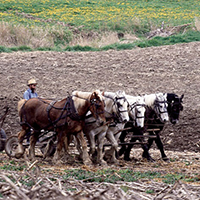
Beyond the Headlines
/ Peter DykstraView the page for this story
Beyond the Headlines Peter Dykstra and host Helen Palmer look at Wisconsin where state government agencies’ websites have removed references to climate change, and delve into the challenges of enforcing environmental regulations in Pennsylvania’s Amish communities, then look back at a time when protecting the environment held bipartisan support. (04:30)

Science Note: New Threat for California Condors
/ Don LymanView the page for this story
The California condor, the largest bird in North America, nearly went extinct in the 1980s, but thanks to captive breeding and release, there are around 400 today. But Reporter Don Lyman explains a possible new threat to the condors: high levels of pesticides and other contaminants from marine carcasses the birds feed on. (02:05)
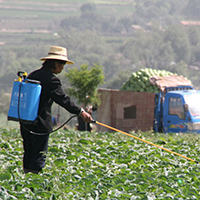
Pesticides Harm Most Endangered Species
View the page for this story
On January 18, the Environmental Protection Agency released its first nationwide evaluation of the harmful effects three pesticides have on virtually all endangered species. Host Helen Palmer spoke with the Center for Biological Diversity senior scientist Nathan Donley about the impact of this rigorous evaluation, and what comes next to mitigate the damage. (06:25)

The Place Where You Live: Spuyten Duyvil Creek
/ Jennifer YoungView the page for this story
Living on Earth gives voice to Orion Magazine’s longtime feature where people describe their favorite places. In this week’s edition, Jennifer Young, a public historian in New York City, weaves different histories into her vision of Spuyten Duyvil Creek, which links the Hudson and Harlem Rivers. (05:35)
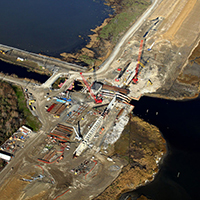
Defending the Gulf Coast
View the page for this story
The Louisiana coast is losing ground in the battle against rising seas. So the state has been working on a master plan to shore up the coast and protect homes with wetlands restoration and higher levees. New Orleans Times-Picayune environment reporter Mark Schleifstein filled in host Helen Palmer about the projects in the updated $50 billion, 50 year plan, and the public response. (14:00)

BirdNote: Owl is Mobbed
/ Mary McCannView the page for this story
Sometimes, as Mary McCann observes in today’s BirdNote, small birds join together to attack a predator, like an owl. It could be a collective response to danger or just a way to raise the alarm. (02:00)
Show Credits and Funders
Show Transcript
HOST: Helen Palmer
GUESTS: Ann Carlson, Nathan Donley, Mark Shleifstein, Jennifer Young
REPORTERS: Peter Dykstra, Jaime Kaiser, Jenni Doering, Don Lyman, Mary McCann
[THEME]
PALMER: From Public Radio International, this is Living on Earth.
[THEME]
PALMER: I'm Helen Palmer in for Steve Curwood. Millions march to show opposition to the new US Administration’s policies, including its proposed rollback of climate action.
WOMAN AT MARCH: America’s kind of led the charge
when it comes to fighting climate change and if we’re just gonna vehemently deny science that we know is happening – we have evidence of it, especially here in New England. I mean come on, it’s gonna be 50 today! It’s January. We need to wake up and we need to work together with the rest of the world to fight climate change.
PALMER: Also, the new EPA nominee and the gag imposed on communication from staff in environmental agencies.
CARLSON: This is the single biggest assault we've ever seen against environmental policies. The Reagan administration in the 80s went pretty hard after EPA but I'm stunned frankly so far at what appear to be really overtly hostile acts.
PALMER: That and more this week, on Living on Earth. Stick around.
[NEWSBREAK MUSIC: Boards Of Canada “Zoetrope” from “In A Beautiful Place Out In The Country” (Warp Records 2000)]
[THEME]
Boston Women March for Science
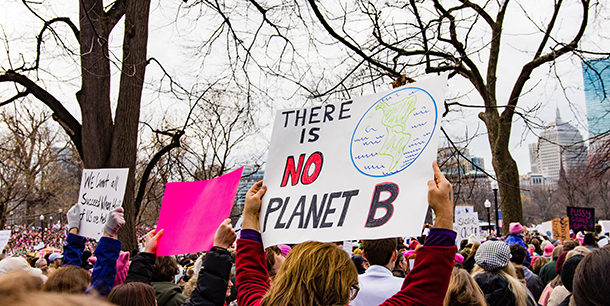
An epidemiologist concerned about how climate change will affect human health held up a sign saying “There Is No Planet B”. (Photo: Jarred Barber)
PALMER: From the Jennifer and Ted Stanley Studios at the University of Massachusetts Boston and PRI, this is Living on Earth. I’m Helen Palmer in for Steve Curwood. The day following the new US President’s inauguration, from Anchorage to Antarctica, from San Francisco to Sydney, millions marched. It was called the Women’s March, but people of all ages and sexes came, from grandmothers in wheelchairs to toddlers in strollers, and many wore knitted pink hats as a sign of opposition. There was no, one motivating message, though many homemade signs showed concern for women’s rights, health care and the environment.

Marchers expressed outrage over a range of issues. (Photo: Jarred Barber)
WARREN: Now I’m gonna say something that is really controversial in some places in Washington. We believe in science. [AUDIENCE CHEERS]
PALMER: Massachusetts Democratic Senator Elizabeth Warren fired up the crowd on Boston Common.
WARREN: Yeah! We know that climate change is real and we have a moral responsibility to protect this Earth for our children and our grandchildren. [CHEERS]
PALMER: That’s Senator Elizabeth Warren. Well, Living on Earth reporters Jaime Kaiser and Jenni Doering were on the common, too. So, Jaime, what was it like?

Even the famous "Make Way for Ducklings" statues wore pink "pussyhats" on the day of the Women's March. (Photo: Naomi Sacks)
KAISER: Well, we arrived two hours before the march even started, but Boston Common and the Public Garden were already flooded in a sea of pink “pussyhats.”
DOERING: I mean, Jaime, even the famous “Make Way for Ducklings” statues wore pink hats.
KAISER: Yeah, that was funny. City officials estimated that 175,000 people turned out, and many had homemade signs and banners that were deeply personal.
DOERING ON TAPE: Can you tell me what your sign says?
WOMAN 1: It says, There is no Planet B.
DOERING ON TAPE: And why are you here today?
WOMAN 1: There are so many reasons! But particularly I’m concerned about our planet and global warming, and we need to act. I’m an epidemiologist, and human health is dependent on a healthy environment.
DOERING: And we ran into several people there who care about science. One woman held up a sign that said “Science Tells the Truth.”
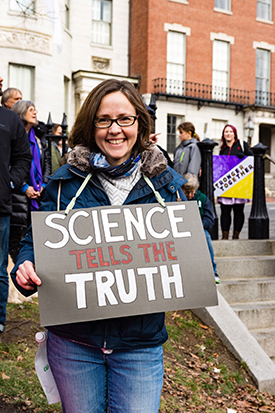
Some marchers held signs highlighting the importance of science. (Photo: Jarred Barber)
WOMAN 2: I think that we’re not living in a post-fact world, and I think there are facts and there’s science that provides us a lot of empirical information, and we know from science that the climate is in trouble, and I’m concerned that this administration is denying that and pretending it doesn’t exist.
KAISER: Officially, the Boston march had partnerships with over 100 national and local groups, including environmental ones. Here’s David Reich, the Chair of the Quincy, Massachusetts, Climate Action Network.
REICH: I’m heartsick and angry at the thought of a president who’s promised to roll back many of the achievements of the climate movement over the last eight years. I’ve noticed that many of his nominees have adopted the new fallback position for climate deniers, which is that climate change is real, and there may be a human component to it, but we don’t really know how large that human component is. It’s another lie.
KAISER: Indignation over what many were calling the new president’s lack of integrity and honesty definitely seemed to be a theme, Jenni.

The Boston Women’s March was held downtown, in and around the Boston Common. (Photo: Jarred Barber)
DOERING: That’s right. Yet the marchers were peaceful, and even joyous and hopeful.
WOMAN 3: America’s kind of led the charge when it comes to fighting climate change and everything else, and if we’re just gonna turn our backs on everything and just vehemently deny science that we know is happening…We have evidence of it, especially here in New England. I mean come on, it’s gonna be 50 [degrees] today! It’s January! We need to wake up and we need to work together with the rest of the world to fight climate change.
DOERING: And, Jaime, I have to say the crowd went wild when the Boston Children’s Chorus sang about togetherness, sisterhood, in the classic anthem America the Beautiful...
CHOIR: And crown thy good with sisterhood...

A child waves a homemade sign. (Photo: Savannah Christiansen)
[CROWD CHEERING ECSTATICALLY]
PALMER: Thanks, Jaime and Jenni. That’s Living on Earth’s Jaime Kaiser and Jenni Doering at the Women’s March in Boston, Massachusetts.
CHOIR: ...from sea to shining sea.
Related links:
- Boston Women’s March Website
- Elizabeth Warren’s full speech at the march
- The Quincy Climate Action Network
Climate Policies a Target for Trump Administration

President Donald Trump signed executive orders in his first days of office to advance the construction Dakota Access pipeline – a recent flashpoint for Native American environmentalists in North Dakota – as well as the famously controversial Keystone XL pipeline. (Photo: The White House Facebook page [Public domain], via Wikimedia Commons)
PALMER: Well, the wishes of the marchers on January 21st are strongly at odds with the agenda of the 45th President and the Republican controlled Congress. Donald Trump has already taken bold steps to undo the climate agenda of his predecessor, with gags on staff at environmental and climate-related agencies, such as the EPA and Interior Department, and executive orders to expedite completion of the Keystone XL and the Dakota Access Pipelines.
But not every policy President Obama put in place can be easily overturned, and to explain what the new President and Congress can and can’t do, we contacted Ann Carlson. She’s the Shirley Shapiro Professor of Environmental Law at the University of California, Los Angeles. Welcome, Ann.
CARLSON: Thank you. It's nice to be back.
PALMER: So, many of the climate agenda items that President Obama put in place were done with executive orders. So, can the new president just get rid of all those?
CARLSON: So, for the most extensive and comprehensive policies, that would be the Clean Power Plan and fuel economy standards to reduce greenhouse gas emissions from vehicles, it's not so simple. That's because these rules have actually gone through a very long public notice and comment process, and so to rescind them and then replace them will require something similar. And they do require that the president do something. So, for example, he can't just rescind the Clean Power Plan and refuse to replace it with any kind of measure to reduce greenhouse gas emissions from the electricity sector, which is the Clean Power Plan's focus.
PALMER: Now, the two executive orders that Mr. Trump signed within his first couple of days in office concern the Keystone XL pipeline and the Dakota Access pipeline. He wants to expedite them. What exactly is he able to do?
CARLSON: So, what he's not able to do is simply say, “We approve both of those pipelines, move forward and start working on them.” The Dakota Access pipeline, for example, is required to engage in an environmental review and will continue to be required to do so.
So, he's trying to expedite the process in, I think, two ways: one is to say speed it up. Two is to signal let's approve these, once we get through the review the outcome should be that we approve them. But he can't just order that result without a relatively lengthy review process, and you can bet that there will be lots of legal oversight from environmental groups, from the tribes that are quite interested in what happens to their land and so forth. So, none of this is going to happen immediately.
PALMER: Now, the Clean Power Plan is the central sort of plank of President Obama's climate action strategy, but that's facing legal challenge anyway.
CARLSON: That's correct. There's a legal challenge right now pending in the DC circuit Court of Appeals that says that EPA went too far in its efforts to regulate the electricity sector.

Statements made by Scott Pruitt at his confirmation hearing cast doubt in the minds of some as to whether the EPA will allow California to keep its ambitious standards for automobile emissions. (Photo: torbakhopper, Flickr CC BY-ND 2.0)
PALMER: Now, Donald Trump appears to feel that the EPA has gone too far. He has put a gag order on that agency and also on other agencies that report on the environment. It seems like he'll be sympathetic to the fact that the EPA went too far, but there's nothing he can do until it comes out of the DC Circuit.
CARLSON: Well, that remains to be seen. The DC circuit has taken the case. I suspect that the next move on the Trump administration's part will be to notify the DC Circuit that the Department of Justice does not intend to defend the Clean Power Plan and may, in fact, intend to withdraw the rule and that will throw the litigation into chaos.
PALMER: Now, auto emission standards are another powerful way in which greenhouse gas emissions can be controlled, and this is an issue that came up in an exchange between the California Senator Kamala Harris and Scott Pruitt in his confirmation hearing.
HARRIS: In your opening statement, you write it is not EPA's mission to be against sectors of industry in general or against particular states. Will you commit, then, to upholding that same standard and recognizing California's authority to issue its own new motor vehicle air pollution standards?
PRUITT: You know, Senator, as you indicated, California was actually regulating those standards before the EPA was actually created, which is why the California waiver exists under statute.
HARRIS: Do you agree to uphold that same standard that has been held by your previous administrators?
PRUITT: I agree to review that as each administrator before me has. It's been granted at times.
HARRIS: Do you agree to uphold it? Reviewing and upholding are two different points.
PRUITT: Senator, as you know, administrators in the past have not granted a waiver and, in fact, have a granted a waiver. That's a review process that will be conducted.
HARRIS: What is your intention, Sir?
PRUITT: I don't know without going through the process to determine that, Senator.
PALMER: What's the importance of this?
CARLSON: Well, this is a really important part of the United States efforts reduce its overall greenhouse gas emissions. Transportation emissions have now surpassed emissions from the electricity sector as the single largest source of United States greenhouse gas emissions, and to address those emissions EPA adopted standards that apply to 2017 to 2025 model year automobiles. The Trump administration has threatened to rescind that rule as well, but here's how this gets really complicated.
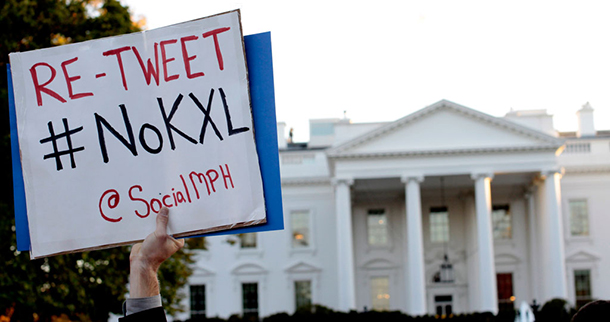
Trump’s executive order revives the Keystone XL conflict that remained a point of contention for years between environmental advocates and Barack Obama’s Administration. Obama formally rejected the pipeline in 2015. (Photo: tarsandaction, Flickr CC BY 2.0)
California under the Clean Air Act has its own power to issue greenhouse gas emissions standards for vehicles. It can only do so if it has a waiver from the Environmental Protection Agency. So, if the federal government rescinds its rules, California's rules can kick in and take their place and because California is so big, that's a big chunk of the national auto market. So, I think what Senator Harris was getting at is, will the EPA rescind California's waiver? Or going forward for new passenger automobile standards will it refuse to grant California permission? And it will be an interesting question whether the Republicans’ commitment to states’ rights is stronger than its opposition to environmental policy or vice versa.
PALMER: Now, obviously during the Obama administration has been a dramatic recalibration of the whole energy picture within the US and, in fact, globally with the rise of renewable power, with the fall in the cost of renewable power. This is a rethinking of the energy picture. Can this be rolled back easily?
CARLSON: No, so I don't think we're going to see a change in market trends that have led to, as you say, a very dramatic reduction in the cost of renewal power, and as a result, a really large expansion of renewable power across the United States and across the globe. There are a few forces that are actually beyond the control of the president that are leading to those changes. One is actually a lot of states requiring that their utilities purchase renewal power or create it themselves, but also massive investment by the Chinese in renewable energy has led to big price drops. Those things are no going to go away. There is a big question about whether the Trump administration will continue to support tax credits for renewable energy. Those have also been really key to getting investments in the renewable sector. I'd be surprised if there is legislation to roll those back, but we may see the ending of them once they expire.
PALMER: How concerned as an environmental law professor are you with the landscape as it seems to be unfolding?
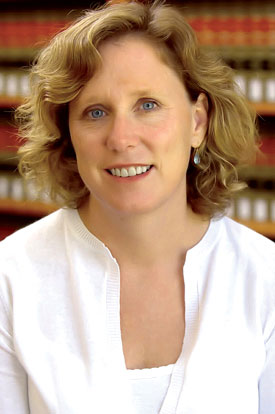
Ann Carlson is the Shirley Shapiro Professor of Environmental Law and the Faculty Co-Director of the Emmett Institute on Climate Change and the Environment. (Photo: University of California at Los Angeles)
CARLSON: I think that this is the single biggest assault we've ever seen against environmental policies. The Reagan administration in the '80s went pretty hard after EPA, but I'm stunned, frankly, so far at what appears to be really overtly hostile acts, like removing EPA's information on climate from its website; gagging EPA scientists and other officials from being able to speak to the press or engage with social media. I could go on, but this is just, appears to be a full-scale assault on every conceivable environmental policy and on even the dissemination of information about environmental problems. We could even see the National Oceanic Atmospheric Administration's research on climate change - really important satellite data that gets collected and so forth - eliminated by this administration. It is extremely alarming.
PALMER: Ann Carlson is the Shirley Shapiro Professor of Environmental Law at UCLA Law School. Ann, thank you very much for spending time with us.
CARLSON: You're very welcome. Thanks for having me on.
Related links:
- Session one of Scott Pruitt’s confirmation hearing
- White House press release about pipeline projects
- LOE segment with more on the legal complications of the CPP
- Washington Post: “Trump administration tells EPA to freeze all grants, contracts”
- Ann Carlson’s analysis on the Pruitt hearing for Legal Planet
- Professor Carlson faculty bio
[MUSIC: Epic Brass, “Solace” on Star Spangled Pops!, S. Joplin/arr. Earl Raney, Ars Nova recordings]
PALMER: Coming up...how pesticides affect endangered species. Stay tuned to Living on Earth.
ANNOUNCER: Support for Living on Earth comes from the Gordon and Betty Moore Foundation, and from a friend of Sailors for the Sea, working with boaters to restore ocean health.
[CUTAWAY MUSIC: Epic Brass, “Lassus Trombone,” on Star Spangled Pops!, J. Fillmore/arr. Earl Raney, Ars Nova recordings]
Beyond the Headlines
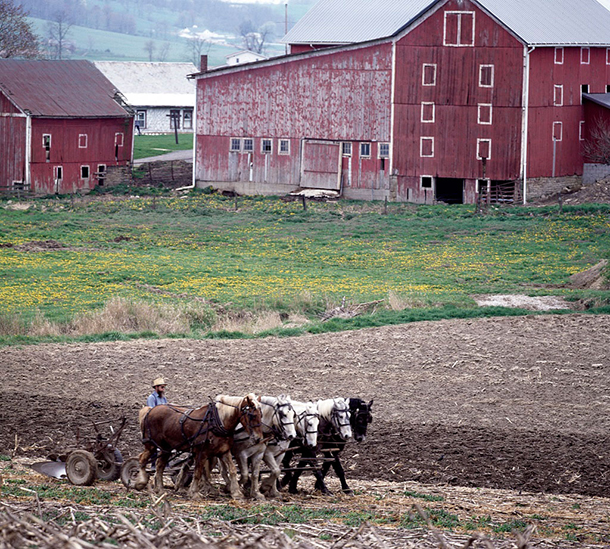
Amish farmers have been using the same methods for hundreds of years. Now local governments are under increasing pressure to enforce new environmental standards within these enclave communities. (Photo: Carol M. Highsmith, Wikimedia Commons public domain)
PALMER: It’s Living on Earth, I’m Helen Palmer in for Steve Curwood. We’ll check in Peter Dykstra and the world beyond the headlines now. Peter’s with DailyClimate.org and Environmental Health News, EHN.org, and joins us from Conyers, Georgia. Hi, Peter.
DYKSTRA: Hi, Helen. So much has changed in the ways we communicate with each other, and I think one of the saddest changes is the decline of the noble book. Even though they don’t kill trees, e-books just don’t do it for me. But one bright side is, if there are fewer books, there are fewer book-burnings, that standard authoritarian tool to stamp out the menace of knowledge.
PALMER: Well, you don’t strike me as a sentimentalist, Peter, and I certainly hope burning tablets full of e-books doesn’t catch on. That would be a nightmare. But I assume you have a point here?
DYKSTRA: Yeah, as a matter of fact I do, because we’re seeing the online equivalent of book burning catching fire – no pun intended — in the Wisconsin government. Two state agencies have taken the cyber-torch to climate change information previously offered to Wisconsin citizens on their websites. The state’s Department of Natural Resources altered its climate change language to characterize climate science as “an uncertainty,” and the Wisconsin Public Utilities Commission deleted its climate change information completely.
PALMER: Well, I’m not sure we should be surprised about that, given that that information’s also gone from the White House website.
DYKSTRA: No, and it’s probably more symbolic than anything else. The state PUC deleted its climate info in early 2016, but nobody noticed it until recently. Meanwhile, the state’s Division of Emergency Management has gone in the opposite direction, posting new information on how climate change will impact the state of Wisconsin through floods, wildfires, and changes in the Great Lakes. Of course I would be remiss if I didn’t point out that the beloved Green Bay Packers were burned to the ground and swamped on the way to the Super Bowl by our local team here in Georgia.

Mexico’s Copper Canyon is a vast wilderness in the northwestern state of Chihuahua. The region has fallen victim to illegal logging, and recently indigenous rights and climate activist Isidro Baldenegro López was killed fighting to protect its decimated forests. (Photo: Lance Fisher, Flickr CC BY-SA 2.0)
PALMER: Well, I’m pretty sure that’s not linked to climate change! What have you got next?
DYKSTRA: A real dilemma regarding cleaning the Chesapeake Bay, religious freedom, and traditional Amish and Mennonite farms. Amish farmers in south central Pennsylvania have pretty much farmed the same way for centuries, using the same non-mechanized equipment.
PALMER: And surely the old-fashioned ways are inherently less damaging.
DYKSTRA: Not necessarily. Even though they’re subject to the same environmental laws as other farmers, it’s not as easy as that. Runoff from horse and dairy cattle makes its way into the Chesapeake’s feeder streams, and so does eroding topsoil. Amish farms don’t tend to have buffer zones, which help protect waterways. And enforcing farm laws tends to create three problems. Many Amish farmers can’t afford to comply with the law. Forcing them to do so runs into religious freedom issues, and non-Amish farmers get resentful when it seems there’s a double standard for enforcing environmental rules and laws meant to protect the Chesapeake.
PALMER: What a dilemma!
DYKSTRA: Indeed. Let’s move on to some sad news. Last March, Berta Cáceres was murdered. She worked for indigenous rights and environmental protection in her native Honduras and was recognized with the Goldman Environmental Prize in 2015. And now, ten months later, a second Goldman winner has been murdered.
Isidro Baldenegro López, an indigenous activist against illegal logging, was shot dead last week. An estimated 99 percent of the native forests near his home in Mexico’s Copper Canyon region are said to be gone.
PALMER: That’s a reminder that international environmental work can be deadly, particularly in Latin America. Let’s turn to environmental history. What did you bring us this week?
DYKSTRA: Well, late January and early February are the traditional time of year for the State of the Union speech. I thought it might be worth noting that, as bitterly partisan as environmental issues are right now, there were times in fairly recent memory when that wasn’t the case. In his 1970 State of the Union speech, Republican Richard Nixon said, “Restoring nature to its natural state is a cause beyond party and beyond factions”. And 14 years after that, in 1984, President Reagan said, “Preservation of our environment is not a liberal or conservative challenge. It's common sense.”

The Wisconsin state government has taken several steps to roll back explicit recognition of climate change, and the state’s Public Utilities Commission has even deleted its climate change information online. (Photo: Taber Andrew Bain, Flickr CC BY-NC 2.0)
PALMER: Well, I doubt we’ll be hearing that kind of presidential rhetoric anytime soon.
DYKSTRA: Yeah, but one final thought on bipartisanship. Eight years ago, when newly-elected President Barack Obama made his picks to run EPA and the Interior and Energy Departments, they all made it through the confirmation process fairly easily and with support from members of both parties.
PALMER: Of course, the President and Republicans in Congress went on to agree about little else after that.
Peter Dykstra is with Environmental Health News EHN.org and DailyClimate.org. Thanks, Peter.
DYKSTRA: All right, Helen, thanks a lot. Talk to you soon.
PALMER: And there’s more on these stories at our website, LOE.org.
Related links:
- Journal-Sentinel: “Wisconsin disaster agency plans for climate change”
- The Sentinel-Record: “Amish targeted over environmental problems”
- About Isidro Baldenegro López, Goldman Prize winner
- President Nixon’s 1970 State of the Union
- President Reagan’s 1984 State of the Union
- Obama’s pick for EPA Administrator
[MUSIC: WebeforeMe “Me and You Be No’ Enemy (We Be Family)” on Lagbaja!, Indigo Disc (a division of PDSE Records, Inc.)]
Science Note: New Threat for California Condors
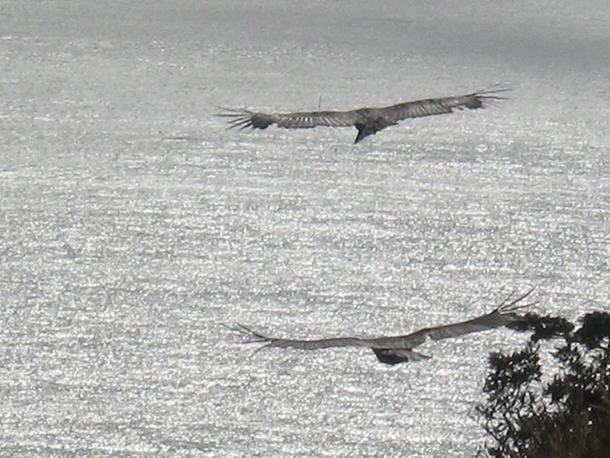
California condors soaring over the Pacific Ocean at Big Sur along the central California coast. (Photo: courtesy of Don Lyman)
PALMER: In a minute, another trip to the place where you live, but first this note on emerging science from Don Lyman.
[SCIENCE NOTE THEME]
LYMAN: The California condor is the largest bird in North America, with a wing span of nearly 10 feet. In the 1980s, only 22 of the iconic birds remained. Thanks to captive breeding and release into the wild there are around 400 today. But now scientists have identified a possible new threat to the condors’ ongoing recovery.
The condor is a type of vulture, and, like other vultures, it feeds on dead animals. One potentially abundant food source for coastal populations is the washed-up carcasses of marine mammals, like whales and seals, but researchers say they might not be safe to eat.
Biologists studying California condors have found high levels of pesticides and other contaminants from marine mammals in the tissues of populations of birds living along the central California coast.
The study's authors found that coastal condors had up to 100 times greater concentrations of mercury, chlorinated pesticides, and PCBs than non-coastal populations. And even though the pesticide DDT has been banned in the United States since 1972, the scientists found high levels of DDE, a breakdown product of DDT, in coastal condors and marine mammals.
The danger for condors comes from the contaminants that build up in mammals’ bodies and have been shown to harm reproduction in other birds, so could threaten the ongoing recovery of California condors. Indeed, the scientists estimate that upwards of 40 percent of breeding-age, coastal condors have DDE levels near the levels that caused thinning of eggshells in bald eagles in the 1950s.
That’s this week’s note on emerging science. I’m Don Lyman.
[MUSIC: SCIENCE NOTE THEME]
Related links:
- The peer-reviewed article published in the journal Environmental Science and Technology
- Audubon: “The Surprising Way Marine Mammals Are Poisoning California Condors”
- Wired: “A Troubling Snag in the Comeback of the California Condor”
Pesticides Harm Most Endangered Species
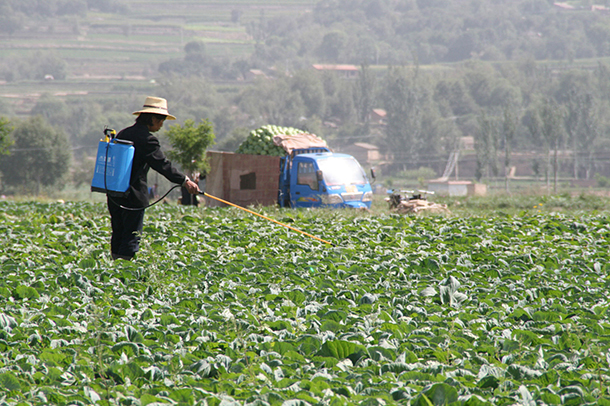
A woman sprays pesticides over a field. (Photo: International Food Policy Research Institute, Flickr CC-BY-NC-ND 2.0)
PALMER: The Environmental Protection Agency released biological evaluations of three common pesticides on January 18, finding they were harmful to virtually all endangered species.
The evaluations are part of an examination with the National Fish and Wildlife and the National Marine Fisheries Services of these widely used products, two of which have been flagged by the World Health Organization as possible human carcinogens. To explain the importance of the evaluations, here’s Nathan Donley, senior scientist at the Center for Biological Diversity. Welcome to Living on Earth Nathan.
DONLEY: Thank you so much for having me.
PALMER: Now, tell me a bit more about these pesticides. What are they, and what are they used for?
DONLEY: Yes, so these three pesticides - Chlorpyrifos, Malathion and Diazinon - they are what's called organophosphate insecticides. They are insecticides, meaning they target insects and pests, but they are organophosphates which means they target the neuronal pathways in insects that happen to be present in almost all animals. So, they are just as harmful to mammals, fish, and other organisms as they are to insects.
Chlorpyrifos is used on everything from watermelons to wheat to soybeans and apples, and Malathion is used on many different crops as well. Malathion is a little bit different too because it is also used to kill adult mosquitoes, so it can potentially be sprayed over vast swaths of the country where there are mosquito abatement programs.
PALMER: So, these biological evaluations from the EPA, these are definitive evaluations. How important are they?
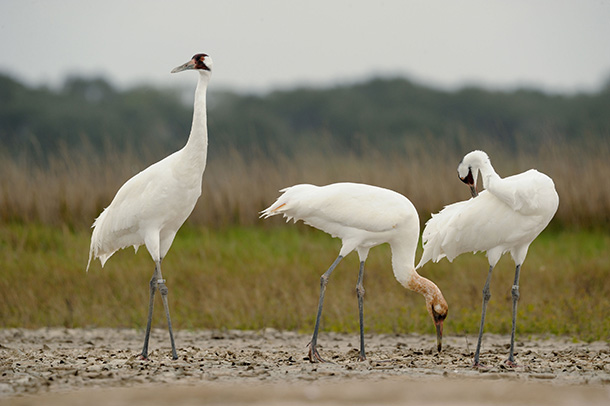
The Whooping Crane is among thousands of endangered species found to potentially suffer from exposure to pesticides. (Photo: U.S. Fish and Wildlife Service, Flickr CC BY 2.0)
DONLEY: They're very important. So, what the EPA found here is that nearly all of the nation's endangered species could potentially be harmed by Chlorpyrifos and Malathion, and three-quarters may be harmed by Diazinon. So, this analysis has really been years in the making and was a collaborative effort between the EPA, Fish and Wildlife Service, National Marine Fisheries Service and the USDA, and what these agencies did was follow the recommendation of the National Academy of Sciences in designing a process to accurately assess risk to individuals of many, different, endangered and threatened species. So, the next step in the process will be the determination by the Fish and Wildlife Services of whether the harm to individuals that the EPA has found in the current analysis will be enough to push the population towards extinction.
PALMER: So, basically, this is the first step in actually a rulemaking as to what should be used. But is the kind of use that they're getting at the moment, the kind of use that is really potentially deadly to these species, or is it just very unlikely?
DONLEY: So, what they analyzed were the current legal uses of the pesticide, and what they did was they looked at the species' range, and then they overlaid a map of where these pesticides can potentially be used and identified which species' range overlaps with the potential use sites. And then they went back and looked at the peer-reviewed literature and they also looked at studies done by the pesticide companies to look at how toxic these chemicals are to different taxa of animals and plants and identified whether those safety thresholds were exceeded.
PALMER: Give me some clue of the kind of species we're talking about. I mean it's 97 percent of all endangered species.
DONLEY: Right. So, it's most of them.

An unlikely species the EPA found to be adversely affected by pesticides is the killer whale (Photo: National Oceanic and Atmospheric Association, Wikimedia Commons public domain)
There's obviously some animals that didn't make the list, you know, for instance, the Polar bear and the Beluga whale, but this analysis did find potential harms to, for instance, the Whooping crane, the West Indian manatee, the Gray wolf, the Miami Blue butterfly, and interestingly some unexpected species were also found to be harmed. For instance, the Killer whale was found to be affected by these pesticides which logically doesn't really seem like an organism that would have much exposure to these farm chemicals; however, this harm was not due to direct contact, but because these chemicals are extremely harmful to salmon, which the Southern Resident orca relies on for food. So, you can get a sense of how in-depth this analysis went, and the EPA and Fish and Wildlife really deserve a lot of credit for putting it together.
PALMER: Now, the next step, as you say, is mitigation policies that are going to be crafted by the US Fish and Wildlife and the National Marine Fisheries Service. Typically are the kind of mitigation policies that they propose adequate?
DONLEY: Well, you know what, this is the first time they've really looked at harms of pesticides to endangered species nationwide. So, there's really not a whole lot of history to base this on, but you know, to tell you the truth, there will probably be some low level measures designed to make sure that these pesticides don't make their way into endangered species’ habitat, but this will likely only have a very minimal impact on agriculture.

Nathan Donley is Senior Scientist at the Center for Biological Diversity (Photo by: Lester Tsai)
And what needs to be stressed is it that this analysis by itself is really not going to result in bans on any of these pesticides. You know, harms to endangered species are really easily dealt with. Just stop using them where these species exist. For most of these imperilled species, this does not cover a whole lot of area, unfortunately, and, from our view, making small concessions on where these chemicals can be applied is more than reasonable; otherwise, we could lose these amazing creatures forever.
PALMER: During the EPA review process, several agricultural groups - and these range from The Cranberry Institute to the California Fresh Fruit Association - commented that these pesticides are actually invaluable for their business, that they really need them. Do you think that's true?
DONLEY: Well, you know what? Our agricultural sector has become addicted to pesticides, and that's really the only way that a lot of farmers know how to farm. I do not believe it's true that we need these toxic pesticides to grow our food, but, until we have really major changes in the way we grow food in this country, that's going to be the talking points used by some of these industry groups.
PALMER: Nathan Donley is senior scientist at the Center for Biological Diversity. Thanks so much for giving us the time today.
DONLEY: Absolutely.
Related links:
- EPA’s announcement of the final biological evaluations
- The CBD press release on the EPA findings
- EPA’s response to comments on the review process
[MUSIC: The Hot Sardines, “Comes Love (Il Amour S’en Fout)” on French Fries + Champagne, by Lew Brown/Sam H. Stept/Charles Tobias/arr. The Hot Sardines with J. Prover/D. Eggar/C. Palmer, Universal Music Classics (a division of UMG Recordings, Inc.)]
The Place Where You Live: Spuyten Duyvil Creek

Aerial view of the Henry Hudson Bridge. (Photo: Metropolitan Transportation Authority of the State of New York, Wikimedia Commons public domain)
PALMER: We take a trip now to New York City for another installment in the occasional Living on Earth/Orion Magazine series “The Place Where You Live.” Orion invites readers to submit essays to the magazine’s website, to put places they care about on the map, and we give them a voice.
[MUSIC: Edward Sharpe and The Magnetic Zeroes “Home” from Edward Sharpe and The Magnetic Zeroes (Rough Trade Records 2009)]
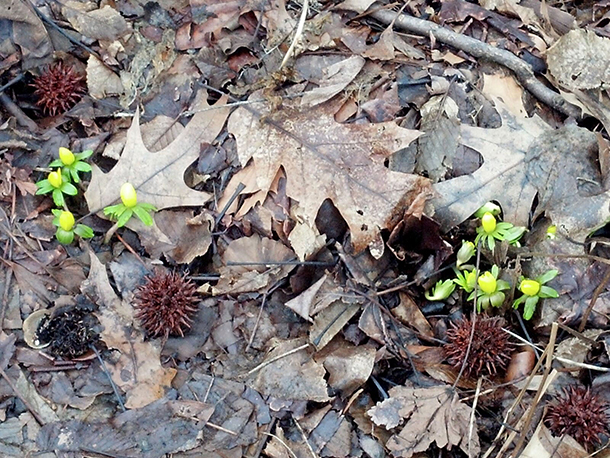
Spring emerges in Inwood Park. (Photo: Jennifer Young)
It was homesickness that inspired today’s essay.
YOUNG: Hi, I’m Jennifer Young and this is my essay, Spuyten Duyvil Creek.
I’m standing at the northernmost edge of Manhattan, looking out across the water at the steel arch of the Henry Hudson Bridge conjoining Manhattan to the Bronx. A leaf-covered pathway curls around the water’s edge. This channel of water separating the boroughs is known as Spuyten Duyvil Creek. The name is hard to pronounce, archaic, Dutch. Guidebooks suggest it originally referred to the river’s choppy, unpredictable tides. A folk etymology claims that the name means “devil’s whirlpool.” Uniting the Hudson River with the Harlem River, the creek has marked Manhattan’s island identity since the last glacial retreat.
Spuyten Duyvil Creek once flowed in an S-shape, but, beginning in the late 19th century, its contours were filled in, to make shipping easier. The creek’s original course is just barely traceable on satellite maps today. The first loop of the creek was cut off in 1895, the bottom part of the sideways “S.” In 1938, the second loop was cut off. Now the shape of the creek is more of a sideways, backwards “L.” Looking at its gentle current today, it’s hard to imagine the furious energy it once possessed, or the forces that muted its turbulent character in the name of progress.
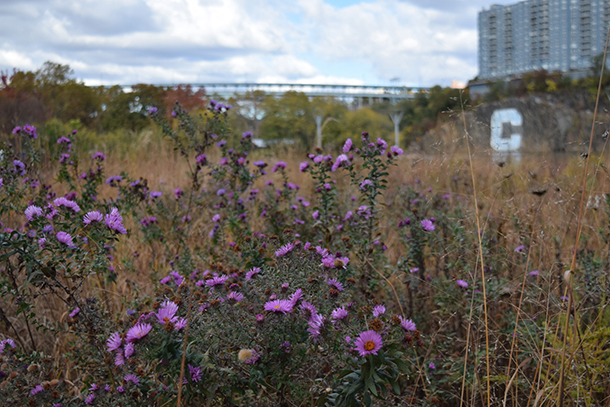
Wild asters in the marsh along Spuyten Duyvil creek with the Henry Hudson Bridge in the background. (Photo: Savannah Christiansen)
Across the creek, almost hidden by apartment buildings, stands a 16-foot bronze statue of Henry Hudson atop a hundred-foot, Doric column. If you squint, you can imagine yourself standing here in an autumn afternoon in 1609, when Henry Hudson sailed up this channel on the Half-Moon. Back then, this corner of the island was used by the Lenape for hunting snapping turtles and wood ducks, fishing for flounder and pickerel, and picking black currants and grapes. The Lenape still call the Hudson River “Mohicanituk,” “the river that flows two ways,” because of the constant tension of ocean water pushing again the river current.
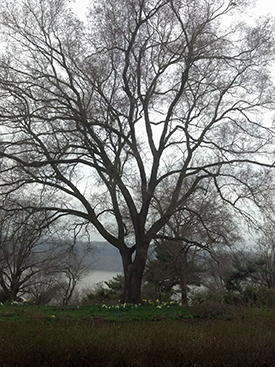
A lone tree in spring near Spuyten Duyvil Creek. (Photo: Jennifer Young)
As I turn to leave, I glimpse an egret standing regally in the briny tidal flats, its reflection startlingly pure and white against the murky water. I think about the S-shape the river once held, and how those riverine curves are mirrored in the egret’s serpentine neck.
[MUSIC: “Nardis” by Miles Davis performed by Chet Baker, Jean-Louis Rasinfosse and Michel Graillier: https://www.youtube.com/watch?v=Vf3Hp8az9jw. ]
I was originally drawn to Spuyten Duyvil because I was looking for a place of wildness in the city. I grew up actually on the west coast of Canada on Vancouver Island, and I moved to Manhattan about 10 years ago, and I was homesick. I really missed oceans and mountains. And I was lucky in that I moved to northern Manhattan into the neighborhood of Washington Heights.
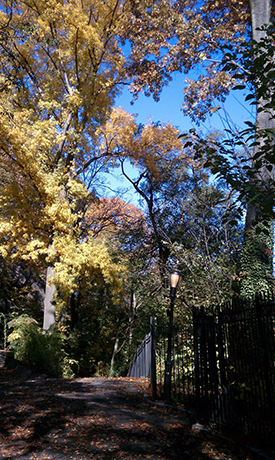
Fall entrance to Inwood Park. (Photo: Jennifer Young)
And there are two amazing urban parks up here. There's Fort Tryon Park and then just above Fort Tryon Park is Inwood Park. And the one word that people use the most to describe Inwood Park is “primeval.” It has the last unlogged original forest in Manhattan. And I found out that there are specifically myths and legends about the creek, starting with the idea that there was a Dutch trumpeter who was trying to warn the Dutch settlement in the Bronx that the British were coming. And the legend goes that he tried to swim across Spuyten Duyvil Creek, and, of course, he failed and perhaps his ghost is still haunting this landscape.
[TRUMPET, THEN BIRDSONG]
There's all these kinds of yellow birds that just flit in and out of the landscape that you can just see out of the corner of your eye for just a minute. There's Yellow Warblers and Red-winged Blackbirds and, of course, all the different kinds of Tanagers and Orioles and Sparrows and the Dark-eyed Juncos, and my favorites are the Northern Cardinals because they're bright, bright red against the greenery.
[CARDINAL SINGING]
What I find when I walk in the park is not only a sense of solitude, but also a sense of community because I walk with my dog. We have many friends that we greet along the way as we walk. And so I look at the boats on the river, and I look out at the Palisades Park behind us, and I feel so incredibly lucky and grateful and wealthy, too, and privileged to live in a place that has such a richness in a natural environment.
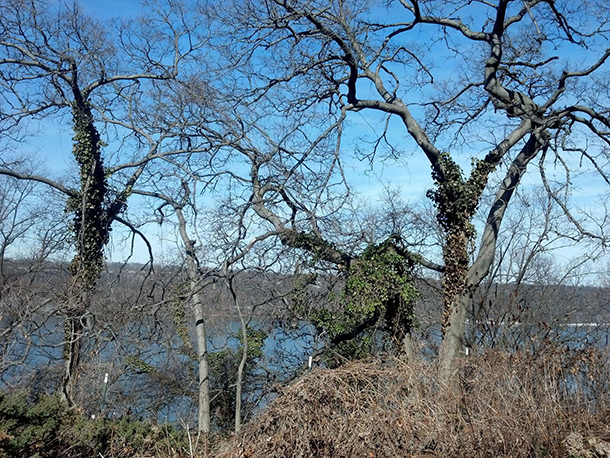
Hudson River view from Fort Tryon Park. (Photo: Jennifer Young)
PALMER: That's Jennifer Young and her essay on Spuyten Duyvil. You can find pictures, and details about Orion Magazine and how to submit your essay, if you want to tell us about the place where you live at our website, LOE.org.
Related links:
- Jennifer’s other essays can be found on her website
- Jennifer’s original essay in Orion Magazine
[MUSIC: “Nardis” by Miles Davis performed by Chet Baker, Jean-Louis Rasinfosse and Michel Graillier: https://www.youtube.com/watch?v=Vf3Hp8az9jw. ]
PALMER: Coming up, ambitious plans to rescue the Gulf Coast. That’s just ahead here on Living on Earth. Stay tuned.
ANNOUNCER: Funding for Living on Earth comes from you our listeners, and United Technologies, combining passion for science with engineering to create solutions designed for sustainability in the aerospace, food refrigeration, and building industries. UTC companies such as Otis, Carrier, Pratt & Whitney and UTC Aerospace Systems are helping to move the world forward.
This is PRI, Public Radio International.
[CUTAWAY MUSIC: Preseration Hall Hot 4 with Duke Dejan, “Wrap Your Troubles in Dreams” on New Orleans, by Harry Barris/Ted Koehler/Billy Moll, Putumayo Records (originally released on Preservation Hall Hot 4 with Duke Dejan, Preservation Hall Recordings)]
Defending the Gulf Coast

U.S. Army Corps of Engineers crews installed a floodwall around a drainage pump station in New Orleans East in 2011. (Photo: U.S. Army Corps of Engineers, Flickr CC BY 2.0)
PALMER: It’s Living on Earth. I’m Helen Palmer, in for Steve Curwood.
The disaster of Hurricane Katrina in 2005 made clear quite how vulnerable New Orleans and the low lying communities along the Gulf Coast are to fierce storms and surging seas. So a master plan was devised to shore up defenses and repair the sinking coastline that protects the city. Now authorities have released an updated $50 billion, 50-year plan that rethinks and bolsters those defenses even more.
Mark Schleifstein, an environment reporter with the New Orleans-based Times-Picayune, has been reporting on the plan and following the public’s response. Mark, welcome back to Living on Earth.
SCHLEIFSTEIN: Well, thank you. I appreciate the opportunity.
PALMER: Now, tell me a little about this new $50 billion plan. What does it propose to do?
SCHLEIFSTEIN: Well, it's actually an update of an existing plan that is in place to provide both restoration for coastal wetlands along the coast of Louisiana, but also with an intent of making sure those restoration projects are combined with projects to improve levees and other structural ideas to reduce risk from hurricane storm surges. And the plan is literally divided in half, $25 billion goes to restoration projects, and $25 billion is going into what you would call protection projects, levees. But also a significant chunk of that money is going into helping people raise homes above hundred-year floodplains and also to, in some cases, to move them out of the floodplains.
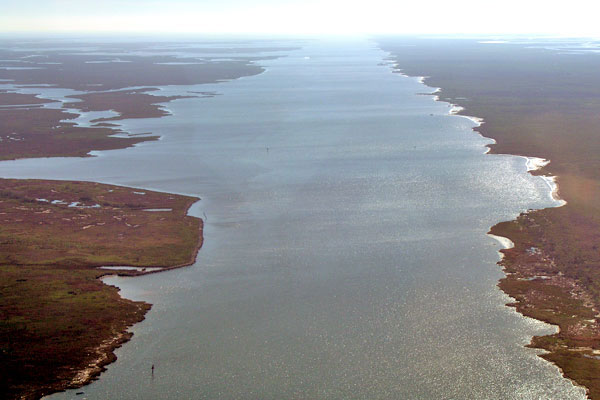
The now-defunct Mississippi River Gulf Outlet, or MRGO (Photo: Jim Flocks / USGS, CC government work)
PALMER: Now, there was a plan before. How does this change the plan before and why did the plan before need changing?
SCHLEIFSTEIN: Well, the reality is that the state has the financial resources, heck of a lot of money from the BP oil spill, to begin construction of some of these projects, and it has a lot more of the science necessary to help design some of these projects, and more information about how high especially sea level will be, which has required them to make dramatic changes in what they would expect to happen.
PALMER: So, basically they've had to update it and make it tougher and make it able to build higher levees and raise houses higher?
SCHLEIFSTEIN: Well, it's more question of what can they save and what they can't, and they've made very clear while they keep talking about $50 billion in 50 years, there's a recognition that the $50 billion is just a start for what will be a continuous, long-term process of providing more protection and more restoration. And the other key piece of that is that there's a clear understanding and recognition by the state written into the report that, unlike the last five-year update, this time they're not saying that we're going to get to a no-net-loss of wetlands situation, that even with this plan in place there will be a significant loss of wetlands along the state's coast. And, indeed, they talk about for their mid-level projection of sea level rise, that the projects that they want to build over 50 years, at the end of those 50 years, they would create 802 square miles, but the reality is that the state would also still lose 2,000 square miles. That's an area the size of Delaware.
PALMER: Wow. And they're actually planning to rebuild some of the wetlands? How are they doing that?
SCHLEIFSTEIN: OK. So, there's two key ways that they’re going to be doing that. One is rather direct. Basically they are going to be mining sediment out of the Mississippi River. There is still enough sediment that the river carries each year that it is building bars and sand deposits within the navigation channel and on the sides of the navigation channel. So, they actually dredge that material out, and they pump it inland through pipelines, and they have pipelines as long as 20 miles already that they’ve been pumping this stuff through to start building wetlands. I mean, literally building wetlands and land across the surface in areas that have turned into open water over the last 80 years.
The other thing that they're doing is, they're attempting to build several sediment diversions, large structures that will be put in the levee system that will capture a portion of the flow of the Mississippi River with its sediment load when there are high river periods and use that material to both build land over a longer period of time and also to have that material added to the wetlands they've already built into the wetlands that exist, to help it keep up with the rising sea level.
PALMER: So, the sediment diversions actually work, do they? They actually manage to build wetlands like that?
SCHLEIFSTEIN: Well, that's a good question, and that's one of the key issues that remains to be seen. You know, these will be the first major sediment diversions of this size, 75,000 cubic feet per second, that will be designed to create wetlands. So, they think, based on their modeling, that it works. They also know based on where they have had diversions for flood purposes - You know, there's the Bonnet Carré Spillway that is just north and west of New Orleans - That spillway is opened up when there's a really high river. That's spillway completely fills with settlement every time they open it up, and it's, you know, 10 miles long, and it's like 30 feet deep.
PALMER: I read that they're actually hoping to rebuild a Cypress Tupelo forest next to the Lower Ninth Ward. That sounds really exciting.
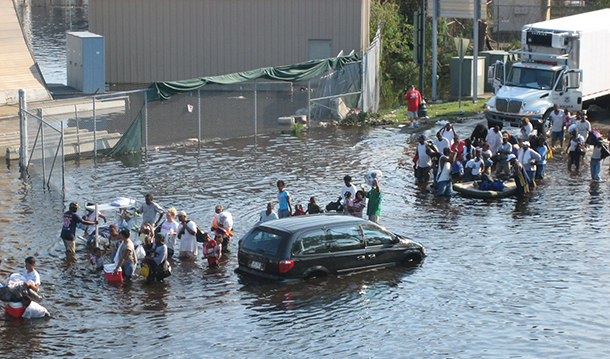
New Orleans residents flee the floodwaters during Hurricane Katrina (Photo: News Muse, Flickr CC BY-NC-ND 2.0)
SCHLEIFSTEIN: That's true. There used to be a shortcut for shipping that went to downtown New Orleans called the Mississippi River Gulf Outlet or the Mr. Go. It was only completed 1965, but since then the Cypress forest that was in that area, what remained of it, has died because of the salt water that it allowed in. After Katrina, it was determined by Congress that that navigation channel needed to be closed because it was no longer financially feasible. It really wasn't even before Katrina. So they dammed it off at a midpoint, and they're going to be filling in part of the area that was a Cypress forest to get it to the depth where they can start growing Cypress trees again.
PALMER: Now, I also read that one part of the plan would actually divert water away from Atchafalaya Basin, and that's the largest wetlands in the country. Why do they want to take water away from the Atchafalaya?
SCHLEIFSTEIN: OK. So, over time, you know, you had the old river control structure above Baton Rouge, and that basically keeps the Mississippi from flowing down the Atchafalaya and creating a Mississippi River in the path of the Atchafalaya. As part of the requirements for that structure, Congress authorized 30 percent of the river's flow to go into the Atchafalaya Basin. Well, since that happened, all the sediment that goes in with that has been filling those wetlands, so it's creating a new delta at the mouth of the Atchafalaya River along the Gulf Coast, but at the same time it's filling those inland wetlands to points where it's problematical. Well, that's a good source of fresh water and some sediment that the state hopes to capture by moving some of that water into the Barataria Bay, where the worst subsidence is occurring now in the state.
PALMER: Now, part of the plan obviously concerns building berms and building bridges and building things to hold some of the water back. Can you talk a little bit about those kinds of constructions that are part of the plan?
SCHLEIFSTEIN: OK. So, the $25 billion that’s set aside for levees and other things to reduce storm surge, some of the key pieces of that include a very long-term, at the end of the 50-year-period, plan to increase the height of the post-Katrina levee system around New Orleans by as much as three feet. The potential there is to improve the storm surge benefits of that system for New Orleans. While the plan sort of talks about it in the context of a 500-year event, the reality is that in 50 years it may very well be that they're going to need that three feet to keep a hundred-year level of protection for the city of New Orleans which would be enough for them to continue to have flood insurance, you know, federal flood insurance, in that area.
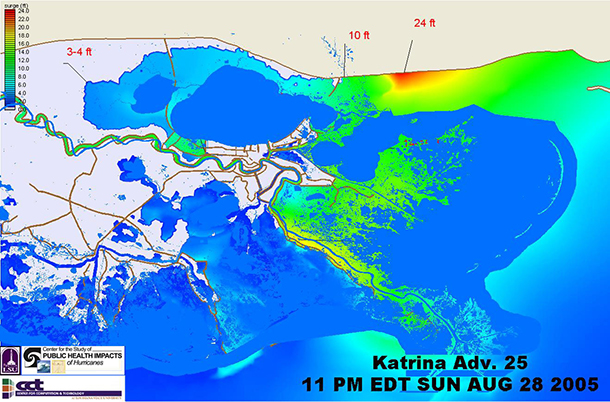
A map showing storm surge during Hurricane Katrina. The areas in red experienced storm surge of 24 feet, and those in bright green experienced 12 feet of surge. (Photo: Matt Ewalt, Flickr CC BY-NC-ND 2.0)
The plan does include a couple of projects that already are in the works. One is something called West Shore Lake Pontchartrain, which is an extension of the New Orleans area levees to the west, and one of the key pieces of that plan is that the Corps of Engineers determined that it would only go through one of the parishes and not two others. And those other two parishes, instead of building a levee through them, they would actually add money to the project to either raise homes above the expected flood plain or to move people out of the floodplain and also to pay, in some cases, for flood-proofing businesses that are in the floodplain.
PALMER: So how, by and large, are the locals responding to this proposed, coastal master plan?
SCHLEIFSTEIN: Well, a number of fisheries groups are not very happy with the diversions. They contend that the additional freshwater will disrupt fisheries. You know, the timing of when shrimp can be caught and where it can be caught, pushing the shrimp out farther away from where the fishermen live and thus forcing them to spend more to catch them. And then with the oysters…You know, Louisiana has long been - or at least until Katrina - had long been a major producer of oysters for the US. There's a clear indication that the additional freshwater from these projects is going to disrupt oyster production.
The other key thing that was raised at a recent hearing was that it may not go far enough to actually deal with the potential effects of sea level rise caused by global warming. The plan itself calls for worst-case scenario looking at 2.72 feet of sea level rise over 50 years, and there have been recent studies out that the amount of sea level rise could be three to four-and-a-half over the next hundred years or even as much as six, when you add in some of the things that are happening with the melting ice caps. So, those issues were raised. The state points out that this is, indeed, a five-year plan and that in five years it will be adopting a new plan, and just like it did this time, it will be upgrading those features.
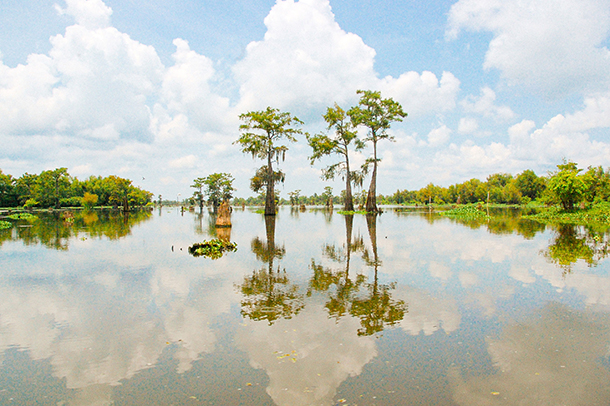
The Atchafalaya basin is filling in with sediment (Photo: matt northam, Flickr CC BY-NC-ND 2.0)
PALMER: Now, you said that obviously the money that's coming from the BP settlement after the Deepwater Horizon disaster is not going to be the whole $50 billion, and you say that even $50 billion may not be enough?
SCHLEIFSTEIN: Well, the state recognizes that $50 billion is enough to do what this plan calls for, and it's a limited plan, so where is it getting that money? Well, the key thing right now is, it’s trying to front-end load some of these projects using the BP oil spill money. It's got $10-$12 billion it expects to get from that for specific projects, all for restoration. For the other things it's going have to rely in part on money from offshore, from the Gulf of Mexico, that's coming from oil leases. One of the problems the state has, though, is that it still has to to pay its share of the Katrina levees, which is going to be $98 million a year for 30 years beginning at that same time in 2018.
So, where else is it looking? Well, it's actually looking at private industry, and it's looking at trading. The state just passed a law that allows a company that is attempting to get a permit to do work in wetlands, you know, it has to do mitigation. Well, it used to be that you had to do that mitigation right there in a small project that it has to do to show exactly what's going on. The state would now allow them to put money into basically the coastal master plan to build some of these projects instead. It also will be able to use money from fines, and Governor John Bel Edwards has made clear that he is filing lawsuits against oil and gas industries all across the state, parish by parish, to attempt to capture at least part of the damages that their earlier use of canals and other things for development of oil and gas within the state's borders, things that they did wrong, using that money to help pay for some of these projects as well.
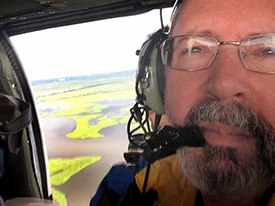
Mark Schleifstein is a Pulitzer Prize-winning environment reporter with the Times-Picayune and is co-leading the newspaper’s new Louisiana Coastal Reporting Team. (Photo: NOLA.com | The Times-Picayune)
PALMER: Is this is a project that is likely to create a lot of jobs for Louisianans?
SCHLEIFSTEIN: Yeah, that's another key thing that's going to occur. You know, after Katrina the reality is, the state benefited from the redevelopment of the levee system which cost $15 billion and all of the construction that occurred in rebuilding everything that was destroyed. A lot of that money ended up resulting in taxes for the state. They're already seeing that there's a viable industry that's being created around coastal restoration, both in terms of engineering for the projects, in terms of a demand for new dredges to do some of the work for dredging and building wetlands. The state hopes and expects that it will be able to actually outsource some of those created jobs to other communities around the world that will need the lessons learned from here in Louisiana.
PALMER: Mark Schleifstein is an environment reporter with the Times-Picayune in New Orleans. Mark, thank you very much.
SCHLEIFSTEIN: Thank you. I appreciate the opportunity.
Related links:
- The 2017 Draft Coastal Master Plan
- The Times-Picayune: “Storm surge damage falls $8.3 billion a year in Louisiana’s new coastal plan”
- USGS fact sheet: “Louisiana Coastal Wetlands: A Resource At Risk”
- Weather Underground: Storm surge during Hurricane Katrina
- About the Atchafalaya Basin
- Mark Schleifstein has been called “the man who predicted the flood”
BirdNote: Owl is Mobbed

Northern Pygmy-Owl (Photo: Mike Hamilton)
[MUSIC: BIRDNOTE - THEME]
PALMER: Animals and birds often behave in ways that seem unexpected, but there’s often a good reason. And, as Mary McCann explains in today’s BirdNote, for small birds, there’s safety in numbers.
http://birdnote.org/show/owl-mobbed
BirdNote ® An Owl Is Mobbed
[Northern Pygmy-Owl tooting]
MCCANN: A pint-sized Northern Pygmy-Owl, not much bigger than a pine cone, hoots from a Northwest tree-top on a winter morning. Before long, this rufous-brown, diurnal owl – a determined predator of small birds and mammals – attracts a crowd.
[Pygmy-Owl plus scolding calls of robins, chickadees, and nuthatches]
Aggravated and scolding like mad, a dozen or more small birds dart back and forth, above and below the owl. Chickadees, kinglets, nuthatches, and a Downy Woodpecker all join the fracas. The owl appears stoic, seeming to ignore this tumultuous rally that ornithologists call “mobbing”.
[Mobbing emphasized]
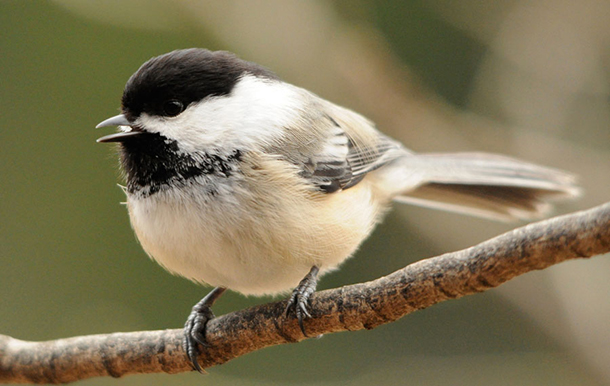
Black-capped chickadee (Photo: PutneyPics)
You might wonder: Why would birds that this aggressive owl regularly eats dare to risk themselves by coming within inches of the predator’s talons?
Scientists believe mobbing to be a collective response to danger. But it’s not certain if the “mobbers” hope to drive the predator off or simply draw attention to the threat. Locally nesting and resident birds are more likely to mob – perhaps because they have more at stake than passing migrants.
[Repeat Pygmy-Owl toots plus scolding calls of robins, chickadees, nuthatches]
I’m Mary McCann.
###
Written by Bob Sundstrom
Calls of the birds provided by The Macaulay Library of Natural Sounds at the Cornell Lab of Ornithology, Ithaca, New York. Pygmy Owl recorded by G.A. Keller, Black-capped Chickadees by R.C. Stein, American Robins by R.S. Little, and Red-breasted Nuthatch by W.L. Hershberger.
Producer: John Kessler
Executive Producer: Chris Peterson
© 2005-2017 Tune In to Nature.org January 2017 Narrator: Mary McCann
http://birdnote.org/show/owl-mobbed
PALMER: And, if you like, you can flock on over to our website, LOE.org, for some pictures.
Related links:
- Listen on the BirdNote website
- More about the Northern Pygmy-Owl from All About Birds
- More about the Black-capped Chickadee from All About Birds
[MUSIC: Dr. Michael White, “Give It Up (Gypsy Second Line)” on New Orleans, Michael G. White, Putumayo Records (originally released on Dancing In the Sky from Basin Street Records)]
Living on Earth is produced by the World Media Foundation. Our crew includes Naomi Arenberg, Bobby Bascomb, Savannah Christiansen, Jenni Doering, Noble Ingram, Jaime Kaiser, Don Lyman, Alex Metzger, Adelaide Chen, and Jolanda Omari. Tom Tiger engineered our show, with help from John Jessoe and Jake Rego, and Thurston Briscoe edited this week. Alison Lirish Dean composed our themes. Steve Curwood is our executive producer. You can hear us anytime at LOE.org, and like us, please, on our Facebook page. It’s PRI’s Living on Earth. And we tweet from @LivingOnEarth.
I'm Helen Palmer. Thanks for listening.
ANNOUNCER1: Funding for Living on Earth comes you, our listeners, and from the University of Massachusetts, Boston, in association with its School for the Environment, developing the next generation of environmental leaders. And from the Grantham Foundation for the protection of the environment, supporting strategic communications and collaboration in solving the world’s most pressing environmental problems. Support also comes from the Energy Foundation, serving the public interest by helping to build a strong, clean, energy economy, from Gilman Ordway, and from SolarCity, America’s solar power provider. SolarCity is dedicated to revolutionizing the way energy is delivered by giving customers a renewable alternative to fossil fuels. Information at 888-997-1703. That’s 888-997-1703.
ANNOUNCER2: PRI. Public Radio International.
Living on Earth wants to hear from you!
Living on Earth
62 Calef Highway, Suite 212
Lee, NH 03861
Telephone: 617-287-4121
E-mail: comments@loe.org
Newsletter [Click here]
Donate to Living on Earth!
Living on Earth is an independent media program and relies entirely on contributions from listeners and institutions supporting public service. Please donate now to preserve an independent environmental voice.
NewsletterLiving on Earth offers a weekly delivery of the show's rundown to your mailbox. Sign up for our newsletter today!
 Sailors For The Sea: Be the change you want to sea.
Sailors For The Sea: Be the change you want to sea.
 The Grantham Foundation for the Protection of the Environment: Committed to protecting and improving the health of the global environment.
The Grantham Foundation for the Protection of the Environment: Committed to protecting and improving the health of the global environment.
 Contribute to Living on Earth and receive, as our gift to you, an archival print of one of Mark Seth Lender's extraordinary wildlife photographs. Follow the link to see Mark's current collection of photographs.
Contribute to Living on Earth and receive, as our gift to you, an archival print of one of Mark Seth Lender's extraordinary wildlife photographs. Follow the link to see Mark's current collection of photographs.
 Buy a signed copy of Mark Seth Lender's book Smeagull the Seagull & support Living on Earth
Buy a signed copy of Mark Seth Lender's book Smeagull the Seagull & support Living on Earth

